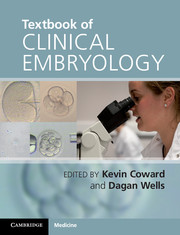21 results
Chapter 13 - Genomics for Embryo Selection
-
-
- Book:
- Manual of Embryo Selection in Human Assisted Reproduction
- Published online:
- 26 April 2023
- Print publication:
- 26 January 2023, pp 135-148
-
- Chapter
- Export citation
Section 4 - ART: skills, techniques and present status
-
- Book:
- Textbook of Clinical Embryology
- Published online:
- 05 November 2013
- Print publication:
- 31 October 2013, pp 219-380
-
- Chapter
- Export citation
Section 3 - Assisted Reproductive Technology (ART)
-
- Book:
- Textbook of Clinical Embryology
- Published online:
- 05 November 2013
- Print publication:
- 31 October 2013, pp 177-218
-
- Chapter
- Export citation
Copyright page
-
- Book:
- Textbook of Clinical Embryology
- Published online:
- 05 November 2013
- Print publication:
- 31 October 2013, pp iv-iv
-
- Chapter
- Export citation

Textbook of Clinical Embryology
-
- Published online:
- 05 November 2013
- Print publication:
- 31 October 2013
Chapter 33 - Preimplantation genetic diagnosis
- from Section 4 - ART: skills, techniques and present status
-
-
- Book:
- Textbook of Clinical Embryology
- Published online:
- 05 November 2013
- Print publication:
- 31 October 2013, pp 346-356
-
- Chapter
- Export citation
Preface
-
-
- Book:
- Textbook of Clinical Embryology
- Published online:
- 05 November 2013
- Print publication:
- 31 October 2013, pp xv-xvi
-
- Chapter
- Export citation
Textbook of Clinical Embryology - Half title page
-
- Book:
- Textbook of Clinical Embryology
- Published online:
- 05 November 2013
- Print publication:
- 31 October 2013, pp i-ii
-
- Chapter
- Export citation
Section 2 - Infertility
-
- Book:
- Textbook of Clinical Embryology
- Published online:
- 05 November 2013
- Print publication:
- 31 October 2013, pp 133-176
-
- Chapter
- Export citation
Section 1 - Mammalian reproductive physiology
-
- Book:
- Textbook of Clinical Embryology
- Published online:
- 05 November 2013
- Print publication:
- 31 October 2013, pp 1-132
-
- Chapter
- Export citation
Index
-
- Book:
- Textbook of Clinical Embryology
- Published online:
- 05 November 2013
- Print publication:
- 31 October 2013, pp 381-391
-
- Chapter
- Export citation
Contents
-
- Book:
- Textbook of Clinical Embryology
- Published online:
- 05 November 2013
- Print publication:
- 31 October 2013, pp v-vi
-
- Chapter
- Export citation
Chapter 34 - Preimplantation genetic screening
- from Section 4 - ART: skills, techniques and present status
-
-
- Book:
- Textbook of Clinical Embryology
- Published online:
- 05 November 2013
- Print publication:
- 31 October 2013, pp 357-363
-
- Chapter
- Export citation
Contributors
-
-
- Book:
- Textbook of Clinical Embryology
- Published online:
- 05 November 2013
- Print publication:
- 31 October 2013, pp vii-x
-
- Chapter
- Export citation
Textbook of Clinical Embryology - Title page
-
-
- Book:
- Textbook of Clinical Embryology
- Published online:
- 05 November 2013
- Print publication:
- 31 October 2013, pp iii-iii
-
- Chapter
- Export citation
29 - Alterations in the gene expression of aneuploid oocytes and associated cumulus cells
- from Section 5 - Pathology
-
-
- Book:
- Biology and Pathology of the Oocyte
- Published online:
- 05 October 2013
- Print publication:
- 24 October 2013, pp 346-352
-
- Chapter
- Export citation
Chapter 10 - Molecular aspects of follicular development
- from Section 3 - Reproductive biology and cryobiology
-
-
- Book:
- Principles and Practice of Fertility Preservation
- Published online:
- 04 February 2011
- Print publication:
- 03 February 2011, pp 114-128
-
- Chapter
- Export citation
Contributors
-
-
- Book:
- Principles and Practice of Fertility Preservation
- Published online:
- 04 February 2011
- Print publication:
- 03 February 2011, pp x-xiv
-
- Chapter
- Export citation
Chapter 7 - Preimplantation genetics
- from Section 1 - Background
-
-
- Book:
- Preimplantation Genetic Diagnosis
- Published online:
- 09 November 2009
- Print publication:
- 28 May 2009, pp 137-150
-
- Chapter
- Export citation
Contributors
-
-
- Book:
- Preimplantation Genetic Diagnosis
- Published online:
- 09 November 2009
- Print publication:
- 28 May 2009, pp vi-vii
-
- Chapter
- Export citation



